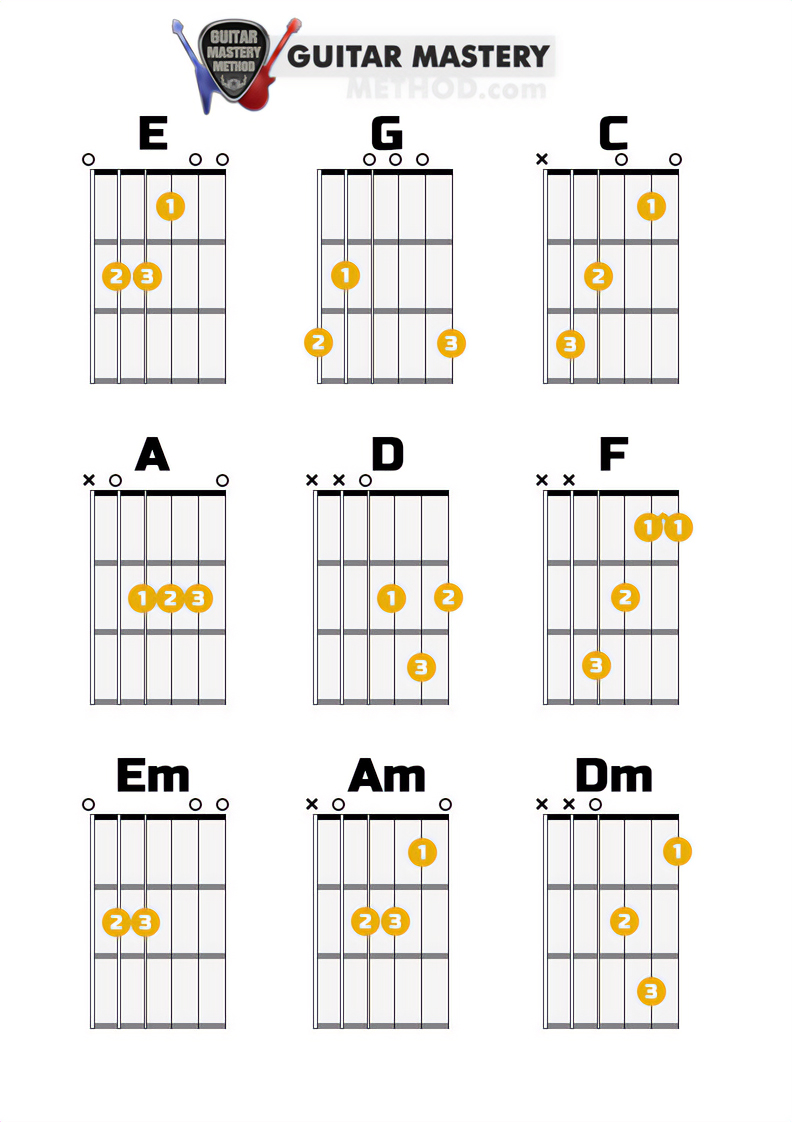So you’ve decided to pick up the guitar and become the next rock star sensation, huh? Well, before you start shredding like Eddie Van Halen or finger-picking like John Mayer, you’ve gotta master the basics. And that starts with learning the must-know chords that every beginner guitarist needs to have in their repertoire. So grab your guitar, tune up those strings, and get ready to rock and roll with the fundamentals that will have you strumming like a pro in no time.
Contents
- 1 Understanding Open Chords: The Foundation of Guitar Playing
- 2 Exploring Major Chords: The Building Blocks of Music
- 3 Diving into Minor Chords: Expressing Emotion Through Strumming
- 4 The Importance of Dominant Seventh Chords in Blues and Rock
- 5 Mastering the Transition Between Chords for Smooth Playing
- 6 Incorporating Basic Fingerpicking Patterns to Elevate Your Sound
- 7 Essential Tips for Clean Chord Changes and Enhanced Musicality
- 8 FAQs
- 9 In Conclusion: Strum on, beginner guitarists!
Understanding Open Chords: The Foundation of Guitar Playing
Open chords are like the bread and butter of guitar playing – without them, you’d just have a bunch of strings on a stick. These basic chord shapes are the building blocks of every rock anthem, country ballad, and pop hit you’ve ever heard. So, if you want to be the next guitar hero, you’d better get cozy with these bad boys.
But what exactly are open chords, you ask? Well, my young grasshopper, open chords are chords that use open strings (hence the name) along with fretted notes to create a full, rich sound. They’re the easiest chords to play because they don’t require you to barre any notes - just a few fingers in the right place and you’re good to go!
Some common open chords you’ll come across include:
- G major
- C major
- D major
- A minor
Now, don’t be fooled by their simplicity – open chords may seem easy, but mastering them takes practice, patience, and a whole lot of finger calluses. So, grab your guitar, crank up your favorite tune, and start strumming those open chords like your life depends on it. Who knows? You might just be the next Jimi Hendrix in the making!
Exploring Major Chords: The Building Blocks of Music
Majestic major chords, the sweet sounds that form the very essence of music. These harmonious triads are the keys to unlocking the magic of melodies and the joys of jamming out like a rockstar. So let’s dive in and explore these building blocks of music that make us tap our feet and sway to the beat.
First off, major chords are made up of three notes: the root, the major third, and the perfect fifth. It’s like a musical recipe where you mix just the right ingredients to create a savory musical dish. Without these three essential notes, music would be as bland as a tofu salad at a BBQ.
Imagine a major chord as a superhero trio, with the root as the fearless leader, the major third as the trusty sidekick, and the perfect fifth as the loyal protector. Together, they join forces to create harmonies so powerful they can make even the toughest critic shed a tear of musical bliss.
So next time you strum a major chord on your guitar or hit the keys on a piano, remember the magical combination of the root, major third, and perfect fifth that make up the heart and soul of music. Major chords are the rockstars of the musical world, so embrace their awesomeness and let the music take you on a journey of sonic delight.

Diving into Minor Chords: Expressing Emotion Through Strumming
So, you’ve mastered the art of strumming those major chords and now you’re ready to delve into the world of minor chords. Congratulations on leveling up your guitar skills! Minor chords have a certain emotional depth and complexity that can really add a whole new dimension to your music.
When strumming minor chords, it’s all about tapping into your emotions and letting them flow through your fingertips. Think of the guitar as your therapist – strumming those minor chords is like venting all your feelings and frustrations into your instrument.
Here are a few tips to help you express those deep emotions through your strumming:
- Experiment with different strumming patterns to find one that evokes the mood you’re going for. A slow, steady strum can convey melancholy, while a faster, erratic strum can express intensity and passion.
- Pay attention to dynamics – use dynamics to build tension and release in your music. Start soft and gradually increase the volume as you feel the emotions building up.
- Don’t be afraid to get a little creative with your strumming technique. Try using your fingers instead of a pick, or incorporate some percussive elements for added flair.
Remember, music is all about expression, so don’t hold back. Let those minor chords be your path to emotional release and musical growth. Happy strumming!

The Importance of Dominant Seventh Chords in Blues and Rock
Have you ever noticed that feeling of resolution mixed with a touch of tension in blues and rock music? Well, you can thank the dominant seventh chords for that! These bad boys add a little spice to your musical journey, creating that signature bluesy feel that gets your foot tapping.
So, why are dominant seventh chords so important in these genres, you may ask? Let me break it down for you:
- They add a bit of edge to your sound, making it more interesting and dynamic.
- They create built-in tension that keeps listeners on the edge of their seats, waiting for that sweet resolution.
- They provide the perfect harmonic backdrop for soulful melodies and killer guitar riffs to shine.
Without dominant seventh chords, blues and rock just wouldn’t be the same. They’re like the spicy seasoning in a musical stew, adding depth and flavor to your sonic experience. So next time you’re jamming out to your favorite blues or rock tune, take a moment to appreciate the genius of those dominant seventh chords!

Mastering the Transition Between Chords for Smooth Playing
Ever find yourself fumbling between chords like a clumsy juggler trying to keep all the balls in the air? Well, fear not, my fellow musicians! With a few key tricks up your sleeve, you can master the transition between chords with ease.
First off, make sure your fingers are properly positioned on each chord before you even think about transitioning. It might sound like common sense, but sometimes our fingers have a mind of their own and end up in all the wrong places. Trust me, your fingers are like rebellious teenagers – they need to be tamed!
Next, practice moving between chords slowly at first. It’s like a graceful dance – you can’t just jump from one move to the next without some finesse. Take your time and focus on each finger’s movement. And remember, practice makes perfect. Or at least it makes you slightly less mediocre.
Lastly, try incorporating some nifty little chord exercises into your practice routine. Not only will they help strengthen your fingers, but they’ll also help you get those transitions down pat. Plus, who doesn’t love a good workout for their fingers? They’ve been slacking off for too long anyway.
Incorporating Basic Fingerpicking Patterns to Elevate Your Sound
So you’ve mastered the art of strumming chords like a rockstar, but you’re ready to take your sound to the next level. Enter fingerpicking patterns – the secret weapon of every acoustic guitar aficionado.
With basic fingerpicking patterns, you can add depth and complexity to your playing, creating a sound that’s sure to impress even the most discerning of listeners. Plus, it’s a great way to show off your guitar skills at your next backyard barbecue or campfire sing-along.
Forget about boring old strumming – it’s time to get those fingers moving! Start by practicing some simple patterns like the legendary Travis Picking or the classic Forward Roll. Remember, practice makes perfect, so don’t get discouraged if you don’t nail it on the first try.
Experiment with different patterns and see what works best for the songs you’re playing. Mix it up, get creative, and most importantly, have fun with it! Before you know it, you’ll be fingerpicking like a pro and elevating your sound to new heights.
Essential Tips for Clean Chord Changes and Enhanced Musicality
So you want to clean up those messy chord changes and enhance your musicality, eh? Well, you’ve come to the right place! Here are some essential tips to help you level up your guitar game:
- Finger Placement: Make sure your fingers are positioned correctly on the fretboard. Don’t let them get lazy and flop around like a bunch of dead fish. Keep them nice and firm, like they’re gripping onto the last piece of pizza.
- Practice, Practice, Practice: Just like trying to break a bad habit of eating cookies in bed every night, changing chords smoothly takes practice. Spend some quality time with your guitar every day and you’ll see improvement.
- Use a Metronome: No, not as a paperweight or a fancy accessory for your desk. Set that metronome ticking and practice changing chords in time with the beat. It’ll help you develop a better sense of rhythm and timing.
Finally, remember to have fun with it! Playing guitar is all about expressing yourself and enjoying the music. Let loose, get creative, and keep striving to improve. Before you know it, you’ll be wowing the crowds with your clean chord changes and killer musicality. Rock on!
FAQs
Why do I need to learn basic chords?
Because if you don’t, your guitar will rebel against you in the middle of the night while you sleep. Just kidding! But in all seriousness, mastering basic chords is the foundation for playing any song on the guitar. It’s like learning the alphabet before you can read.
What are some essential chords every beginner should know?
Think of basic chords like your survival kit in a zombie apocalypse. You’ll need to know your A, C, D, E, G, and F chords to navigate through the musical world. These chords will give you the power to strum your way through countless songs.
How can I practice and remember all these chords?
Repetition is key, my friend. Practice switching between chords until your fingers develop muscle memory. It’s like riding a bike – once you get the hang of it, you’ll never forget. You can also create mnemonic devices to help you remember which fingers go where.
What should I do if my fingers hurt from pressing down on the strings?
Ah, the joys of calloused fingertips! As they say, no pain, no gain. Give your fingers a break when they start to ache, but don’t give up. Over time, your fingertips will toughen up and you’ll be able to shred like a rockstar without flinching.
Can I still play songs with just basic chords?
Absolutely! Some of the greatest songs ever written are made up of just a few basic chords. Just ask Bob Dylan or Ed Sheeran. So don’t underestimate the power of simplicity. With some creative strumming patterns and a dash of your own style, you can make those basic chords sound like magic.
In Conclusion: Strum on, beginner guitarists!
Congratulations on mastering the basics and learning these must-know chords! Remember, practice makes perfect. Keep strumming, keep playing, and before you know it, you’ll be ready to move on to more advanced techniques. Rock on!


